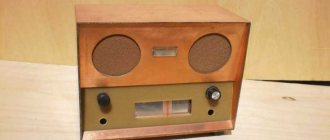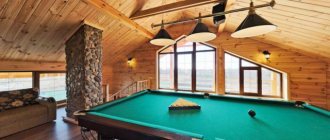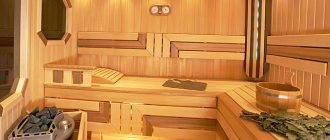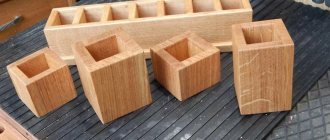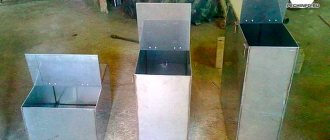Gangs and tubs
You can’t do a bathhouse without gangs, tubs, buckets and basins. The best material for bath utensils is wood. As a rule, they are made from oak or larch wood. Because this wood can withstand high humidity and heating to high temperatures well.
So what bath utensils are absolutely necessary?
Steamer
A steamer is a small container with a lid that has a hole for a broom handle. A bath broom is steaming in the steamer.
Gang for a bath
Bathhouses are most often made of cedar, pine or linden. Because their wood has a healing effect on humans. These are low but wide containers. Shakes are designed to rinse the body, usually with warm water.
Buckets
Buckets are intended for dousing with cold water after a steam room. Waterfalls are often made from buckets; this is a tipping system using a rope.
Purpose of cooperage products
- A tub is a small “bucket” made of wood, equipped with two small handles - “ears” (hence the name). It is customary to store cool water in such a container for rinsing after a steam room. In addition, a hanging bath tub can be used for steaming brooms (in the absence of a steamer)
- A wooden or copper ladle is perhaps the most necessary container for a steam room. Its main purpose is to “water” the stones with water to produce a large amount of steam. In addition, you can use the ladle to rinse off after the procedure.
- Shayka is a small wooden basin that can be used both for washing and steaming brooms. If you want to get maximum pleasure from visiting the steam room, you should buy a sauna bowl made of natural wood - the plastic basins that replace the steam baths are not able to maintain the “correct” water temperature and do not fit the overall interior of the steam room.
- A steamer is a highly specialized container designed for steaming brooms. In warm water, brooms become soft, which is extremely important when using them. In addition, brooms lying in the steamer begin to spread a pleasant birch aroma throughout the steam room.
Tub
A large tub with protruding “ears” with holes at the edges. Sticks were inserted into them when the tub needed to be dragged from one place to another. As a rule, a tub was used to store or transport water. Two people carried it, since it was not always possible for one person to lift the tub.
Lohan
This is a large, roomy vessel, which was intended for various household needs. The housewife used the tubs for washing dishes or washing clothes.
These containers were made of metal or wood. The shape was different, as was the volume. There were tubs with legs and special stands, which made them very convenient to use.
Difference from gang and tub
Those who love baths usually try to follow the traditions and order of the procedure. But for the best effect and greater benefit from bath procedures, it is worth choosing and using all the accessories for the steam room correctly.
For example, few people know the difference between a gang and a tub. Indeed, they are similar, but there are still key differences.
The gang is less capacious; it is always made in a horizontal form. It can have one or two handles and can be used without a lid.
Bath accessories: nice little things
Aromatic oils, scrubs, nourishing masks, herbal infusions are not a necessary attribute of a bath. But they make your stay even more enjoyable, creating a special atmosphere and comfort. As well as all kinds of interior accessories: signs and signs.
A bathhouse equipped with the necessary utensils will bring indescribable pleasure and drive away illnesses. Because it’s not for nothing that people say: “The bathhouse soars, the bathhouse rules, the bathhouse will fix everything.”
Features of sauna cages
You can’t do without this accessory in the steam room. It is used in almost all bath procedures. This universal product can be used to supply water to the stones in the steam room, contrast dousing, stirring aromatic oils in water, and brewing herbal healing infusions for inhalation. Bath bowls are made mainly from the following materials:
- Linden
. Products made from this wood are practical, light and comfortable. They heat up more slowly due to the low thermal conductivity of the material. In addition, linden contains phytoncides - biologically active substances beneficial to the body. Due to the absence of tanning components, the water in such a vessel lathers easily. - Oak
_ Such gangs are very strong and durable, although in some properties they are inferior to their fake counterparts. In particular, they heat up faster, and the water from them lathers worse due to the tannin content. - Copper
. The design is easy to use and maintain. It is equipped with a wooden handle to prevent burns.
Most often, wooden utensils are used in the bathhouse, since wood has optimal performance characteristics for an aggressive environment. Wooden bathhouses are more environmentally friendly and safe. It is impossible to get burned by them. In addition, they fit harmoniously into the interior of the steam room. However, such gangs require special attention and care.
How to choose a steamer for a bath
The first condition when choosing a steamer should be the presence of a lid with a hole for the broom handle. It doesn’t matter whether it is purchased or homemade. The second and important condition is that it must be made from natural materials - wood from one of the following species: oak, larch, cedar, aspen, pine, linden...
Steamers made from plain and stained oak or larch have proven themselves to be excellent. With proper care, they will serve for many years to the delight of you and your loved ones.
It is important that the steamer is made with high quality, practically perfect. Then there will be no problems with water leaking through cracks and crevices. It must be made of smooth wooden elements with tongue-and-groove rivets (planks) and reliably glued with environmentally friendly glue that can withstand both prolonged exposure to moisture and high water temperatures.
The internal and external surfaces of the steamer must be treated with moisture-resistant impregnations, for example, natural beeswax or a special polyurethane composition. Its design should be convenient to use. The presence of elements such as handles and hoops made of stainless steel or tropical rattan will give it both strength and functionality.
You should also choose the right volume of the steamer so that at least two brooms can be steamed in it at the same time, for example, oak and birch. For a real steamer, this is the norm, but if the sauna is designed for several people, then a larger volume may be required. Fortunately, nowadays you can easily purchase a wooden container, starting from five liters and ending with 30 liters, or even more.
And the last thing you need to pay attention to is the design and color tone of the wooden steamer. It should not look like a foreign object, but should complement and fit harmoniously into the interior of the bathhouse and steam room.
Tips for choosing
The gang is of great importance in the bathhouse. The comfort of the entire procedure largely depends on it. Therefore, it is important to consider certain criteria when choosing.
- Number of users. In general, it is recommended to purchase individual gangs with a small volume. So, products for 4 liters or 6 liters will be just right. If you definitely need one container for everyone, then you should give preference to 25 liter models.
- Wooden products are very capricious. It is important to store them exclusively in a dry place, away from a heat source. It is worth considering a special room in advance or completely abandoning the purchase of a wooden gang. An alternative would be a metal product. It is less demanding.
- Application options . The shaker is used for more than just pouring water. With great comfort, you can steam brooms and prepare herbal infusions in the container. Some plants have pungent odors. So, you should purchase small wooden or plastic containers for each set of herbs.
- Ergonomics of handles. Convenience is of great importance, especially with large volumes. The handles must match the size of the gang. It is important to ensure the appropriate size and quality of fastening.
Usage
Modern bath utensils are made of high-quality material. Metal elements are made of stainless steel. If the inserts are plastic, then they are not designed for too high temperatures.
If you rarely visit the bathhouse, then tubs made of combined materials (for example, wood and steel) are best suited. The fact is that completely wooden containers, when left idle without water, tend to dry out and may begin to leak. Even so, they can be revived by soaking them in water and allowing them to swell.
Modern tubs can be used for different purposes : water is poured into them for irrigation on stones, brooms are steamed, aromatic herbs and oils are diluted. When purchasing a tub, it is important to remember several rules that will make it last longer:
stored in a cool room with little light. They should not be exposed to dry in direct sunlight or near heating devices . In such cases, the wood will simply dry out, and the containers will lose their shape or even fall apart. The tub should be stored upside down . This is necessary so that it is ventilated. Periodically, the container needs to be checked for integrity , to see if the metal rings are coming apart. If the rings are loose, they can be tightened.
It is important to maintain hygiene and clean the tubs regularly.
Products that are free from chemicals and odor should be used. This is one of the main rules, otherwise the next time you go to the bathhouse, when you want to dilute aromatic herbs or oil bath brooms, they will begin to smell like chemicals, which will be more noticeable at high temperatures.
You can learn how to repair a tub in the next video.
Source
Cooperage craft
Just a century ago, wooden utensils and accessories were widespread. First, all the utensils, including the tubs, were hollowed out from a tree trunk: the insides were taken out of it and a cylinder was obtained. The bottom was attached to the bottom, and ears were cut out from the top, thanks to which, in fact, this vessel got its name. A rope was threaded through these ears, serving as handles for carrying the tub, or a rod holding the lid.
Gradually, the cooperage craft developed and, from a certain time, wooden utensils began to be made from special staves or frets. When you look at barrels, tubs, fonts, buckets, your soul becomes joyful and warm; they have an ideal shape, which craftsmen have honed over many centuries.
Staves can be sawn or chipped, the latter being more durable. Their production requires the cooper to have a sense of wood and great skill, as they must be clean and even. Therefore, do-it-yourself bath tub
can only be done by someone who knows and has studied cooperage well. Craftsmen have long noticed that raw wood splits better. Therefore, in the old days, rivets were prepared directly in the forest, at the site where trees were felled. The prepared frets should be thoroughly air-dried in a ventilated place for three months. Previously, drying was accelerated using a Russian oven - the ends of the staves were sealed with paper using wood glue and placed in a well-heated oven. Within a day they could be used to make barrels or other utensils.
The staves are tightened with wooden hoops - from lilac shoots, bird cherry or spruce branches; elm, oak, hazel, and maple are also suitable. For small cooperage projects, hoops are made from linden bark. To make the product more durable, hoops are made of metal, but this is used with great caution, since iron leaves unaesthetic rusty marks on the wood.
In cooperage, as in any craft, there are many secrets and subtleties that need to be carefully studied in order for the results of the work to be successful. The nuances of making wooden products are passed on to next generations, and now in Russia the demand for it is quite high.
Self-production (drawing and dimensions)
Before you start making a wooden basin for a bath with your own hands, you should select the material from which it will be made. It is usually made from oak or linden. Linden wood is especially suitable for making basins. The product turns out to be light.
In addition, linden does not conduct heat well, and therefore the water in it cools slowly and the walls practically do not heat up. The content of fetoncides in it has a positive effect on human health. The water in the linden bowl lathers well. This product can be considered ideal, if not for the high price of raw materials.
Important! The walls of oak basins quickly heat up due to high thermal conductivity, but oak bowls are durable and strong.
Bath basins come in two types:
- an ordinary basin for washing is shallow, but wide enough;
- tub or steamer - during the entire bathing procedure, a large basin is the main one for steaming the broom, and with the same water you can “catch up” the steam.
When starting to make a gang, you need to select all the material. It is recommended to make the hoop wooden to prevent burns on the body. It is also made from stainless steel. It’s easier to work with, you won’t feel the color of the wood. The process begins with the preparation of small dry treated boards.
Advice! Drying should be done at room temperature. The room must have a good ventilation system. This procedure lasts about a month.
Next comes preparing the template. All planks should be the same, and two should be cut larger. Handles will be attached to them.
The hoop can be made of metal. Stainless steel is best for this.
Important! It should be remembered that the workpiece must have a thickening on both sides for the lock.
- The rivets are tied together with rope, and they should be fitted closely. The rope will secure the product;
- Use a pencil to mark the location of the hoop. The hoop is tried on the product, fastened with a rope, and the location of the lock is outlined;
- a hole is made at the ends of the hoop on both sides so that the ends overlap each other;
- the hoop is pulled onto the base of the pelvis, the holes are aligned and fixed with a rivet.
Next, the manufacture of the bottom begins. A groove is made at the base. To do this, a hole measuring 1.5-2 cm is drilled in the rivets and knocked down with nails. The bottom is cut out separately. In diameter it should be equal to the circumference plus 1-1.5 cm.
Important! When the blanks are made, two are cut out larger, as mentioned earlier. They are located exactly one opposite the other. Handles are cut out of it
Types of bath brooms
This accessory is intended not only for active massage, but also for creating a unique aromatherapy that arises from the leaves of the plant used. During bath procedures, beneficial inhalation also occurs, which helps in the treatment of many diseases of the upper respiratory tract. Let's talk in more detail about which broom is best for steaming in a bathhouse and what effect it has on the body.
Birch branches
In Russia, this option can be found almost everywhere. It is considered one of the best for use in a steam room. This is due to the fact that birch branches have a gentle effect on the skin and cleanse internal organs, increasing blood circulation. The branches of the described plant are very flexible and are capable of maintaining elasticity for a long time after drying. During the procedure, the adhered leaves absorb sweat and toxins, thus cleansing the skin. After whipping, the pores are cleaned, which allows the skin to breathe and better absorb various beneficial substances.
Oak branches
Oak leaves are especially useful for caring for oily skin. Thanks to the essential oils, tannins, quercetin, quercitrin and pentosans included in the composition, an oak broom cleanses the skin and makes it more elastic. The steaming procedure using this accessory will have an anti-inflammatory effect and speed up the skin regeneration process.
Eucalyptus branches
Used in the bath for the treatment of colds, as well as for their prevention. The shoots have a strong, specific smell that not everyone can withstand. For this reason, most often several eucalyptus branches are added to an oak or birch “bouquet”.
Juniper branches
They contain a huge amount of essential oils, vitamins and beneficial amino acids that have a bactericidal effect. The bush does not have sharp needles, but the legs themselves are prickly. This option is quite tough and is more suitable for experienced bath attendants. Before using it, you need to learn how to steam with a juniper broom. The steamer should lower it onto the skin not tangentially, but directly. Some people first wrap their prickly paws in a light cloth and lie on them. Juniper is useful for liver and kidney diseases. This plant can also eliminate the symptoms of some skin diseases.
Alder branches
The leaves have an adhesive property; they stick to steamed skin and draw out toxins from it. Using this option prevents joint diseases.
Fir branches
They have a general strengthening, anti-inflammatory and bactericidal effect. It is the fir, unlike its other prickly counterparts, that is more suitable for soaring. Its soft needles have a gentle effect on the skin. The use of the plant is indicated for respiratory diseases.
Ladle for a sauna - what is it for and how... Ladles for a sauna: a review of wooden and... How to choose a ladle for a sauna?
The aroma has a positive effect on the nervous system, has a calming and relaxing effect. When steamed, essential oils penetrate the skin and have a softening and rejuvenating effect. Before use, it is important to learn how to properly steam with a fir broom. You need to start stroking from the neck area and ending with your toes. Next, the sides are processed: first on one side, and then on the other. The use of fir is contraindicated for skin diseases.
Artemisia branches
Because of its bitter aroma, it is most often used as an additional component of a birch or oak “bouquet”. Wormwood is indicated for diseases of the respiratory system and gastrointestinal tract. During the massage, herbs have a relaxing and calming effect.
Bamboo
It is not traditional for a Russian bath; it is brought to us ready-made from Asia.
The plant contains silicic acid, which improves the condition of skin and hair. Vaping bamboo is also used to relieve symptoms of depression. Below is a useful video on how to steam with a bamboo broom.
Linden branches
They have a positive effect on the kidneys and promote the healing of small wounds. Massage with linden branches can eliminate headaches and normalize sleep.
Thus, all plant products can be divided into three categories:
- deciduous;
- conifers;
- prefabricated
Having learned about the beneficial properties of a “bouquet” of various plants, it’s time to talk about how to use this accessory in a steam room.
What it is?
The tub is one of the most ancient types of dishes; it was used in Rus', in the 13th century. Such products, as a rule, were made from birch, oak or other species of deciduous trees. The most popular tree for the production of antique tubs was oak.
Today, good tubs are made from the same types of wood. The peculiarity of production is that they are produced without the use of varnish and glue, without adding any foreign synthetic materials. This means that these devices are truly natural. For a more reliable fastening, a metal hoop is used, which is not afraid of corrosion even in conditions of high humidity.
Such a container is needed for a bathhouse, because it allows you to completely immerse yourself in this atmosphere. Wood products are pleasant and useful to use because they transmit heat and have an incredibly subtle scent.
Rug
A wooden mat is another very useful thing that will allow you to maintain personal hygiene in a bathhouse or sauna. In addition, the mat will help you avoid slipping and getting burned while visiting the steam room. Depending on the size, it can also be used either as a seat or as a lounger. Wooden bath mats are often made from alder, which is well preserved for many years and perfectly withstands temperature changes.
Summary
We examined the question of what types of sauna ladles there are, what they are used for and what they are made of. Traditionally, a wooden sauna ladle is used, but you can choose a convenient combined one, as well as a modern polycarbonate ladle (also find out how to choose a sauna stove).
Conclusion!
These simple tips will help you choose a ladle and ladle for a bath, which can be purchased both at retail outlets and in online stores. Enjoy your shopping and visits to the bathhouse!
: 1 122
Number of blocks: 18 | Total number of characters: 17154Number of donors used: 8Information for each donor:
- -kovsh-dlya-bani: 3 blocks out of 5 used, number of characters 4656 (27%)
- : 2 blocks out of 4 used, number of characters 2693 (16%)
- : 1 blocks out of 4 used, number of characters 498 (3%)
- -saun/: 1 blocks out of 4 used, number of characters 1058 (6%)
- : 1 blocks out of 4 used, number of characters 684 (4%)
- : 1 blocks out of 3 used, number of characters 1533 (9%)
- : 2 blocks out of 4 used, number of characters 3873 (23%)
- -dlya-bani/: 6 blocks out of 8 used, number of characters 2159 (13%)
Thermometers
For the steam room I would like to buy a special thermometer made of wood. In appearance, it resembles the well-known room thermometer. Typically, bath thermometers are made of mercury, protected by fireproof glass from exposure to high temperatures. But instead of mercury, an organic liquid colored in a certain color can be used for safety.
Such thermometers can take the form of a ladle, an oak leaf, a samovar and other symbols of a bathhouse. They are capable of measuring temperatures from 0 to 180 °C.
A round thermometer will decorate the steam room. In appearance it looks like a watch. It has a wooden base. This thermometer is not afraid of water drops and lasts quite a long time. Its scale has divisions from 0 to 120 °C. But such a device may allow errors in determining temperature. This is its disadvantage. A digital thermometer made of steel or heat-resistant plastic gives accurate readings. It has a sensor with a cable up to 1 m long. This thermometer is the most versatile and accurate of all sauna devices. With its help, you can find out what temperature prevails in the steam room, even while in another room. Such a device is capable of measuring temperatures from 0 to 225 °C. Naturally, it costs more than others, but the error of readings when using it is only 0.5 °C.
The sauna station combines a digital thermometer with a hygrometer. It allows you to simultaneously find out the temperature in the steam room and the air humidity in this room. Such equipment may look different. There are devices with two dials, as well as combined devices with two scales and arrows.
Rules of care
The scope of use of wooden utensils narrowed along with the widespread use of ceramic and porcelain utensils. However, although they are good and practical, ceramics and porcelain are not suitable for all cases. Thus, a bathhouse and a sauna, at any time, are unthinkable without wooden utensils and special bath accessories , and using ceramic, porcelain or metal utensils in a bathhouse is extremely impractical, and this violates established bathhouse traditions.
It should be borne in mind that containers made of wood require special care, operation and storage. The fact is that wood is extremely sensitive to changes in humidity, and it tends to dry out over time. If you notice that such an inevitability has occurred, then the dishes need to be filled with cool water. So it needs to be allowed to stand for some time so that it is saturated with moisture. Then pour out the cold water and pour boiling water over the cooperage product. This will help him return to his previous form. Also, we must not forget to thoroughly rinse cooperage products after each use and scald them with boiling water.
Please note that when interacting with various foreign substances, wooden products can often change color. This is completely normal and does not affect their performance properties in any way. To prevent tubs and other wooden products from drying out, they are stored away from sunlight. It is best to leave them on the floor, on the bottom shelf in the steam room or in any room without windows.
If you strictly follow all the simple rules described above, then your bath accessories will last as long as they once served our ancestors.
What is a bathhouse?
What is a steamer for?
The most complete pleasure from a bath can only be obtained with a high-quality and properly organized steaming process, and this is impossible without a bath broom (birch, oak, linden - it depends on individual taste). You cannot simply use a broom without prior preparation - you will ruin the whole impression of the bathhouse, and this borders on a crime. And the correct preparation of a broom consists of steaming it, i.e. soaking for a certain time in hot water. This process can be carried out in almost any container (bucket, gang, basin), but it would be more correct to use a special container for this purpose - a steamer.
This is the name for cooperage products that resemble a bucket or bucket with high sides and allow you to place brooms in it. As a rule, the steamer is equipped with a lid with slots for the handles, which allows you to maintain the desired water temperature inside for a long time and prepare the brooms for bath manipulations in the best possible way. A broom placed in a steamer and pressed with a lid does not float, and the branches and leaves that form it are steamed most evenly.
What types of steamers are there?
Based on their shape, there are low (horizontal) and high (vertical) steamers. Place the broom lying down in a low position, which ensures uniform temperature along its entire length and, as a result, better steaming. But tall steamers are much more convenient: the brooms in them are placed vertically and such containers take up less space, which is important for small steam rooms. And the cost of vertical steamers is usually lower than horizontal ones. We have already talked about the role of lids. In the assortment of online stores you can find offers for steamers both with and without a lid, but you should not be tempted by such savings. A “correct” steamer must have a lid. Only under the lid is the broom truly steamed, and the water is not contaminated with random debris.
Materials for steamers
Undoubtedly, the best material for a steamer is wood. This is due to the unique physical properties of wood and its natural aroma formed when interacting with heated water. When using a linden steamer, a subtle linden scent will be transferred to the broom, and a cedar steamer will add a healing and pleasant pine aroma to the entire atmosphere in the steam room. Oak, larch, and birch are also used to make these products, and each material has individual properties. On sale, along with completely wooden products, there are steamers with inserts made of stainless metal or plastic. Those. the wood in these models does not have contact with hot water, and you should not expect a specific aroma from it. But they have another advantage: they will never dry out or leak from all the cracks, which can happen with rarely used wooden containers.
How to choose a steamer
When choosing a steamer, you need to consider the following:
- A steamer with a lid is always better than without it. It is desirable that the lid has holes for broom handles;
- For a small steam room, a tall steamer is more suitable; it will save you space. For a spacious steam room, low and wide steamers are preferable;
- Pay attention to the quality of the product and the wood itself. A poorly processed rough surface and multi-colored wooden elements usually indicate unsuitable quality. There is a high probability that the fit of the rivets is not tight enough and the product will leak. Do not be enchanted by the favorable price, do not buy an obvious defect;
- Buy completely wooden containers only if you plan to use them quite often, at least 1-2 times a week. If less often, from time to time, then models with metal or plastic inserts will be more suitable for you. They do not have to be pre-soaked before each bath;
- All cooperage products should be made in the same style and, if possible, harmonize as much as possible with the overall style of your bathhouse, and not look like foreign objects.
These products are distinguished by a characteristic feature - a long handle, which is convenient for scooping high-temperature water from a container (bucket, barrel). It is to avoid burns that scoops are made either entirely of wood or metal (copper, brass, stainless steel) with a long wooden handle. The choice of these accessories is huge: different in shape and volume, with many finishing options and a wide range of prices. The main criterion when choosing is that you should be comfortable using this item, although the price of this convenience is also significant. The handle should feel pleasant in your hands, and the overall appearance of the product should correspond to your aesthetic feelings (but at the same time not cause regrets about wasting money).
Buckets, gangs, tubs
Without all these products, a full-fledged bathing process is impossible. These containers are used not only for hot and cold water, but also for all kinds of infusions, decoctions and other bath gadgets. Without them, you can’t steam your feet or wash your hair. The range of these products is huge, they vary in volume, shape and source materials. For their manufacture, wood is used (usually birch, oak, less often larch, cedar, linden), metals (stainless steel, copper, brass, aluminum), and plastics.
The buckets of these items are the tallest: their vertical size significantly exceeds their width. A mandatory element is a handle (or two handles) for carrying - metal or flexible, made of rope (for wooden buckets).
The gangs, on the contrary, are the lowest and widest. They may have two handles on the sides with holes for the palms, one handle, or they may not have handles at all.
Tubs are usually much smaller in volume than buckets and buckets. Larger tubs usually have two short handles on the sides for easy grip with two hands, while small-volume models (3-4 liters) may have only one handle, which makes them look like scoops.
In fact, it will not be possible to strictly differentiate all bath accessories according to their belonging to one type or another, because strict criteria simply do not exist. In the old days, in Russian baths, a tub was a bucket with two wooden “ear-handles” along the edges for easy pouring. A shayka was a smaller container with one handle.
Nowadays, containers of a sufficiently large volume (from 10 to 30 liters) with two handles with holes for fingers, or without handles, are usually called gangs. A tub is a smaller container (from 3 to 10 liters) with one or two handles, which is used for diluting aromatic oils, brewing various herbal infusions and dousing the body with similar solutions. An illustration of the blurriness of classifying characteristics is a product popular on the Internet called a “tub gang”, which is a tall gang with one handle.
What else you need to know about bath containers
For long service life of bath utensils, careful care is required. This is especially true for wooden containers. They are made from separate elements - rivets, which are connected to each other using micro spikes without the use of any glue. After assembling the entire product, it is tightened with metal hoops for strength. The tightness of the joints of the rivets and their tightness depend not only on the quality of the assembly, but also on the moisture content of the material.
The fact is that wood has a very specific relationship with water: at low humidity, wood shrinks, products made from it dry out and lose their tightness. To restore it, cooperage products are immersed in water for a day. The wood swells, the rivets fit tightly together and the container can again be used for its intended purpose (the same is done with new wooden accessories before their first use).
It seemed that it would be possible to leave buckets and buckets of water in order to avoid shrinkage, but this cannot be done - the water may bloom and the wood will become covered with a green coating. Therefore, after the bath, all containers are emptied, dried and placed bottom up on some kind of stand or grill (for ventilation). Cooperage products should not be forced to dry near hot surfaces or in the sun. It is best to store them in a cool and dark place.
If the walls of the pile, bucket or tub still bloom, you must:
- thoroughly rinse the bottom and walls with hot water and soda;
- drain the hot water and rinse the container with cold water;
- fill the container ¼ full with spruce branches and brew it with boiling water;
- rinse with cold water and can be used again.
Periodically you need to check the tension of the tightening rings on tubs, buckets, and piles. If they are loose, they should be tightened by lightly tapping them with a hammer on the hoop along the rivets in the direction of expanding the container.
It should be noted that the range of bath accessories offered today includes many models of wooden steamers, bowls, tubs with inserts made of plastic or stainless steel. All of them are very practical, look great, while maintaining the pleasing appearance of natural wood. And at the same time, they are free from the disadvantages associated with wood drying, because The metal or plastic containers located inside are responsible for the tightness. And maintenance of such accessories is minimal. If you use the bathhouse irregularly, then this choice will be the most appropriate.
Why do wooden barrels dry out and why do you need to soak new barrels?
The answer to these questions must be sought in the physical and biological nature of wood. And specifically in its property as shrinkage. Everyone knows that wood can be dry, damp or wet and have probably experienced how difficult it is to light a fire with damp brushwood. But humidity for wood is not always a minus. Water in the structure of wood is presented in two states: free, filling the space between wood fibers, and bound, contained inside the cells. A decrease in the content and even the loss of all free moisture does not entail changes in the geometric dimensions of the wood.
On the contrary, the removal of intracellular moisture leads to their noticeable reduction. This phenomenon is called shrinkage. Wood reaches its minimum size when all bound moisture is completely lost, this is called complete volumetric shrinkage. This figure for different species reaches 11-17%, which must be kept in mind when producing lumber from roundwood, making the necessary allowances. For wooden cooperage products (barrels, fonts, gangs), complete volumetric shrinkage means the appearance of cracks in the joints between the rivets and loss of tightness. In such cases they say: “The barrel is dry!”
However, shrinkage is not a final phenomenon. The tree can regain the intracellular moisture lost during drying quite quickly, as soon as it is immersed in water or kept in a humid environment. The opposite of shrinkage will occur and is called swelling. It is notable for the increase in the physical size of wood with an increase in the content of bound water. During swelling, as with shrinkage, the maximum increases occur perpendicular to the fibers (thickness, width), the minimum increases occur in the longitudinal direction (length). Swelling is considered a negative property of wood, but it can be beneficial when it is necessary to tightly fit wooden parts to each other: in vats, barrels, boats, etc. That is why new wooden bath equipment (buckets, gangs, tubs) are soaked before first use ( swell) in water for at least 24 hours.
Good luck to you in understanding all the secrets of the art of bathing, good health and good mood. And, of course, with light steam!
Gang for a bath
A sauna bowl is a wooden vessel that looks like a bucket, with the only difference being that the bowl is slightly lower and wider than the usual size of its “comrade”. Also, a bathhouse has one (if the bathhouse is small) or two handles on the sides (if the bathhouse is large). So, the number of handles always directly depends on the size of the gang. Therefore, for many years now, a sauna bowl has been a convenient utensil that will never, under any circumstances, burn your hands, even in those moments when hot water is poured inside it (the safety of the bowl is maintained by comfortable and reliable wooden handles).
What are bathhouses made of?
Often a sauna bowl is made from linden. After all, linden has long been considered one of the best materials for making bath utensils. As a rule, products made from it are light, comfortable and very practical. In our time, they began to make gangs from oak (sometimes alder), because oak has long been famous for its strength and durability. There are also sauna bowls made of copper (copper bowl). Its ladle is made entirely of copper, and only the handle is made of wood, so that you will never burn your hands when you take the hot ladle. In addition, there are balls made of oxidized copper. Thanks to the same wooden handle, they are also comfortable and easy to use.
How to use a sauna washer correctly?
However, a sauna bowl can be used not only for adding clean water to the steam room. In addition, the gang is also suitable for contrast dousing procedures (hot, cold water), dissolving oils, brewing all kinds of herbal infusions, tea, and other aromatic liquids, thanks to which you will pamper your body with inhalations. Which is especially important in the spring, when our respiratory tract is at risk of colds.
The ladle is a reliable helper for the gang in the bathhouse
However, in addition to the bathhouse, another multi-purpose assistant accessory is a ladle. Thanks to its long, comfortable handle, the scoop can be used to apply water to stones from a safe distance. Also, with its help, you can easily and quickly fill gangs and tubs with water, and carry out the dousing procedure (both for yourself and your friend).
There are many types of scoops, ranging from the ordinary wooden scoop to a huge selection, namely... stainless steel scoop (wooden handle), lacquered copper scoop (with wooden handle), oxidized copper scoop (wooden handle), copper scoop (with wooden handle). Also today, manufacturers of bath accessories have made sure that you can choose a ladle, either separately or together with a convenient set. Such as: a set of “bowl plus a ladle” (made of natural wood), a set of “tub plus a ladle” (made of copper, but the handles of the ladle itself and the tub are also made of wood for your safety).
Bath bowl plus ladle
So, when going to the bathhouse, do not forget that a bathhouse plus a ladle is the basis of bathhouse utensils, which you cannot do without. After all, procedures in the steam room are not only rest and relaxation for the whole body, but also an excellent opportunity to strengthen, and sometimes even improve your health, with the help of all kinds of procedures, just how to do inhalation without a gang, and douse yourself with water without having it at hand a convenient scoop? No way, right, so when you stop a step away from the bathhouse, check if you took everything and if you did forget something? Don’t be lazy, come back and grab a bathhouse and a ladle with you!
DIY bath tub
The tub is the most ancient type of utensil. These products are usually made from aspen, oak, birch and other deciduous trees. Tubs have been used in Ancient Rus' since the thirteenth century. During excavations at the site of Ancient Novgorod, the remains of rivets were found, from which it was possible to recreate the container used in those days. It turned out that they had a cylindrical shape, were stable, comfortable and were used for carrying water, storing wine or oil, and so on. In Russian art and literature, the tub symbolizes celebration and feasting. There is a well-known popular print “How mice buried a cat.” It dates from the seventeenth century and depicts mice rejoicing at the funeral of their main enemy, the cat. One carries a box of pies, another plays the bagpipes, and everyone else holds tubs of beer and mead. The inscription under the picture reads: “The mice bring a tub of good drink.” It can be noted that since those ancient times, the appearance of this dish has remained unchanged, only now it is used not for drinking, but as a bath accessory. Also used in bathhouses are the ancient steamer and shishka containers. Water is carried and stored in a tub, herbal infusions are made in a bowl and flavorings are diluted, and brooms are naturally steamed in a steamer.
The peculiarity of the tubs is their ears, formed by two longer rivets located opposite each other. The walls of these products are inclined inward, which allows less water to splash than in dishes with straight walls.
For a cooper who is good at making barrels, it is easier to make a tub, since in this case there is either no need to bend the rivets at all, or just a little bit. But in any case, the work begins with a drawing, according to which the shape and the required number of rivets are determined. Then templates are made for them, blanks and a bottom are made from them.
